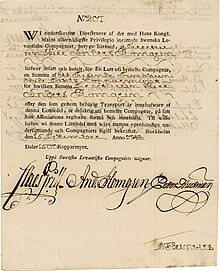Swedish Levant Company
The Swedish Levant Company (Swedish: Levantiska kompaniet) was a Swedish chartered company founded on 20 February 1738 with the exclusive right to trade in the Levant for a period of ten years.[1]
Background
Following the surrender at Perevolochna, King Charles XII was exiled to Bendery in the Ottoman Empire.[2] It was during this time that Charles began to seek closer ties with the Ottomans, and Sweden's interest in the empire began to rise.[3]
The primary backer for trade with the Ottoman Empire was Swedish Board of Trade member Johan Silfvercrantz.[3] He proposed following the example of the English Levant Company to import goods such as silk while exporting Swedish products to the region.[3] Charles sent Silfvercrantz to the Levant to explore a future trade relationship, but he was unable to complete his work before his death the next year in 1712.[3]
In 1718, Charles died, and this marked the end of autocratic kingship in Sweden.
In 1737, a trade agreement between the Ottomans and Sweden was signed.[6][3][7] A direct result of the treaty was the formation of the Swedish Levant Company.[7][8]
Founding

The establishment of the company was a controversial issue.[3][7][10] Major issues included which powers the Riksdag should grant the company. Members of the Hat Party generally argued for the English Levant Company structure, but this strategy was criticized by some merchants who favored a freer Dutch method while trading with the Ottomans.[3]
The results saw a compromise between the parties.
It had a starting capital of 200,000 daler silvermynt.[3][7] The two major shareholders of the company were Gustaf Kierman and Thomas Plomgren.[10][8] Unlike the earlier-formed Swedish East India Company, investment was limited to Swedish merchants only.[10]
Trade
Sweden had hoped to conduct a profitable trade with the Ottomans whereby it could export iron[3][11] and naval ammunition to Southern Europe.[11] In return, luxury goods would be imported into the country.[3]
Closure
The board of directors petitioned the Riksdag for the renewal of its charter, which was granted for an additional 10 years, until 15 January 1748.[1] However, the trading company saw the profits from its primary activity begin to languish.[1] The Private Committee in 1752 made recommendations to the Privy Council for the Riksdag to take additional measures to increase Levantine trade. This effort, however, failed; the company charter was officially revoked in 1756.[1][10]
References
- ^ a b c d e Westrin, Th., ed. (1912). Nordisk familjebok (Lee – Luvua) (in Swedish) (16 ed.). Stockholm: Project Runeberg. pp. 289–290. Retrieved 13 May 2019.
- OCLC 617650689.
- ^ ISBN 978-91-554-6003-7. Retrieved 22 May 2019.
- ^ ISBN 9780803247505.
- ISBN 978-2-7283-1260-3. Retrieved 27 May 2019.
- ^ "From Rep. of Turkey Ministry of Foreign Affairs". www.mfa.gov.tr. Republic of Turkey Ministry of Foreign Affairs. Archived from the original on 2 April 2015. Retrieved 22 May 2019.
- ^ ISBN 978-88-6453-856-3. Retrieved 13 May 2019.
- ^ ISBN 978-951-746-941-8. Retrieved 13 May 2019.
- ^ Adolf Frederick of Sweden (1738). Kongl. May:tz Nådiga Resolution Angående Sweriges Siöfart Och Handel på Levanten. Gifwen Stockholm i Råd-Cammaren, den 20. Febr. Anno 1738 (in Swedish). Transcribed by Lars Bruzelius. Stockholm: Boktryckeriet. Retrieved 20 May 2023.
- ^ ISBN 978-1-351-90202-1. Retrieved 13 May 2019.
- ^ ISBN 978-2-84050-755-0.
